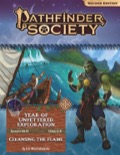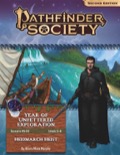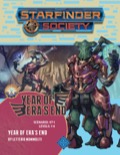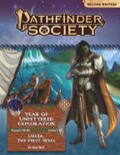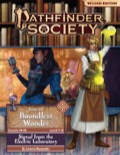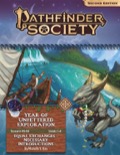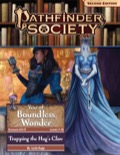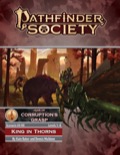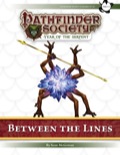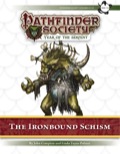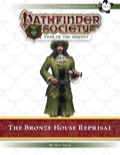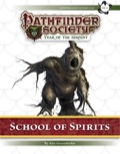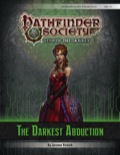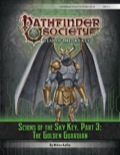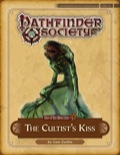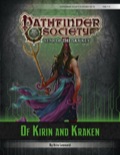Sign in to create or edit a product review. Played this at the high-end of low tier. This was an extremely fun high-tier scenario. The premise was refreshing and unusual, the fights (mostly) varied, and some of the things you encounter and discover really hammer home that this situation is slightly above the heads of even the Society's most experienced agents. I particularly adored the exploration system used here. After a year of (over)use of the 'Chase' subsystem, the way the Activities are set up here is both wildly creative and well-executed. Our party really had to think and make decisions (and trade-offs) in how we wanted to approach it. Difficulty-wise the final encounter's 'boss' is exceptionally hard yes. Though the scenario does broadcast that fact and give the PCs a choice not to engage, which seemed fair our own party got fairly lucky in bringing them down quick, but that can happen when two maguses both roll very well. My least favorite encounter was the penultimate one - one of the enemies' abilities meant that while we never felt in real danger at all of dying to them, it came across as massively reducing our chances of winning any subsequent fights which felt excessively punishing. Overall very fun, 4 1/2 stars. Now, how do I feel about how this fits in with the Pathfinder Society as an organization? Metaplot thoughts:
Badly. 322/Waterfall/Csilla stole from the Society, murdered one of its leaders, then later stole from it again to impersonate/become a Decimverate member for years. Even if the circumstances surrounding her past actions are being considered along with her intent to redeem herself through good works - which I could buy, though its comical how every NPC accepts this so quickly and that the sole leader who objected to it (Eando) upon its reveal here makes a huge show about going 'nevermind, I was wrong, we cool' - it makes the Organization look insanely incompetent. Apparently if a PC steals the right fancy hat they get to be in charge of everything no-takes-backsies.
The resolution of this thread (or specifically the lack thereof) is greatly lowering multiple of my character's opinions of the organization they are a part of, some PCs to the point of re-thinking 'why is a person like me committing myself to such a deeply unprofessional group'? But that is a 'metaplot'/larger developer note. I'm not holding this specific scenario at fault for it :) Played at high tier. For the first ~2/3rds of this scenario our party was really vibing with this. There's a bit of a mystery in what's going on, an investigation that leads to an interesting reveal of the culprits and their motives, and then some combats which include 'win/lose' conditions that are more than just 'who kills who first'. Though the second and third encounters, at least at our tier and scaling, seemed to have virtually identical sets of combatants which was less interesting And then the last bit of the scenario comes in. Where all of our actions and choices seemed to be swept aside so Paizo could lay lore track for a plot they want to do - a plot they sort of already did the very last time PFS engaged with the Burning Orcs. Our party found the NPCs' request at the end to be fairly nonsensical and bizarre as something Pathfinders would be expected to do. And when we finally agreed mostly because it was very clear the scenario was directing us to do it anyway, the addition of other combatants to the fight due to CP scaling made the entire situation even more absurd. The meat of the scenario is good. But the end really brought the mood down and left a sour impression. This and 4-15 feel like things Paizo in a few years will point to as a case of 'PFS missions affecting the world!', when in reality the 'important' parts of it play out just like a 'press X when prompt comes up' QTE level of 'affecting' things. GM'd this at high tier. This is a very solid 'delve'-type scenario. The rooms and location are nice and flavorful (including several fun hazards that are easy to understand but feel creative), the plot is fairly straight-forward, and the layout and editing is pretty good With one major exception: there is not a specified map for the first encounter. I don't think this is inherently a bad thing - it gives GMs like myself a lot of leeway into coming up with an interesting map - but I sincerely doubt it was intended. Many of the combats felt a bit on the easy side (though at high tier the final fight has an enemy where the results of a single save will cause the encounter's challenge to vary wildly), and I feel the first bit of 'evidence' the PCs stumble across is so revealing to established players that it would be better found later in the scenario, but overall a well-done scenario. Ran this for a low tier party. This scenario takes the PCs on a quick tour across parts of the elemental planes in order to get themselves and their allies back home safely. I appreciated the attempt to showcase a variety of encounter-types and not just have this be six fights with different elemental-flavors. The presence and role of three of the NPCs involved - two other Pathfinder agents and an ifrit they may have dealt with before - was also nice: it's good both to see other Pathifnders and their own jobs going along in parallel to our own missions, as well as having a 'local guide' for one of the planes to highlight its unique beauty. Unfortunately, trying to squeeze all the elemental planes together into a single scenario is too much. Especially now that there are 6 rather than 4 there wasn't enough time to really absorb any of the inividual plane's quirks or what made them special. Instead each was just another leg to quickly pass through to reach the next step. I did at least appreciate that even if the presentations of the Planes felt a bit lackluster, the descriptions of how the other Planes' incursions onto them was throwing things awry were well done and evocative Fitting all six planes in and giving them each their own sets of obstacles also seems to have led to an unusually high amount of editing issues. Two of the encounters are confusing to understand how they are meant to be run as written, while a third the final encounter seems to not include an option that many parties would want to try to take. Encounters:
Event 2 - the Fire Plane chase - appears to actually be written as a modified chase where the PCs automatically advance each round regardless of their rolls, but at the end their total successes and failures affect the outcome. I have no problem with this - it's my prefered chase system honestly - but this interpretation of the Development/Success conditions seem to contradict both the Chase rules desrcibed before the chase (which call out the default Chase rules in the GM Guide) and the scaling adjustments noted on the same page (whihc are meaningless if the Devleopment section is accurate and intended since each obstacle is overcome regardless).
Event 3 - the Earth Plane hazard - seems to be you use sonics to free the keystone, with Consonite Needles possibly hurting you as you approach it to try. But since the Sap doesn't actually do anything its odd to have it fully statted as a Hazard (just says the skill check the PCs need to make), the Needles hazard's description seems less than clear (it mentions it can trigger again, but is that for everyone who approaches, or on each separate attempt to dam the water flow?) and laying out the skill check to dam the water and break the keystone free both in the Sap Hazard is odd (since as written both action need to be done, but the actions themselves are taken 15+ feet away from each other). It can be parsed, but as laid out on the page took me a frustratingly long time to envision how it was supposed to work. Final encounter - to avoid a very tough! fight you need to talk the jann down. (quite a bit: four total successes across two round with only Diplomacy as a listed option. Even creatively allowing for some other possible options (I let a PC's Legal Lore be used as they argued that the Society should not be held fully accountable for thieves' commitment of the further crime of trespassing on our property for example) that is putting a lot of expectations on parties who may only have one or two even passable diplomats. But the bigger issue is that even if they calm the jann you then need even more checks to get the theives to give back their loot? the same theives who caused all of this, almost killed a Pathfinder (if your party wasn't around Idrix the kobold would drown as his water breathing runs out), and literally begin their interactions with the PCs by asking for their help in saving them from the Jann? My party calmed Shurrizih but almost failed at this last needed check to get the thieves to give his stolen property back. Which as written would mean they would have needed to fight the jann until wither he or them died, all so that the two NPCs most of the party hated would be able to get away learning nothing. The fact this last check exists/there is not a path to turning Yeyacha and Gedun over to the jann feels like an oversight: my party and looking at the other reviews, several others as well found them to be a criminal nuisance that the scenario seems to assume we should take responsibility for without doing the work to justify why
I also noted above that three of the NPCs were good inclusions. The other two - the titular thieves - very much less so. The scenario seems to want them to come across as charming 'Robin Hood' types, but other than a sentence or two does not really do the work to make that work. Even the item they stole is left unnamed - its nature and how specifically it could be used to possibly help others is left undefined. What's left then is the PCs seeing a pair of non-Pathfinders trespass, destabilize our place, endanger others, and draw the wrath of a powerful genie onto us...and then try to shrug their shoulders at the whole ordeal and walk away learning nothing. My party took an immediate dislike to them one player being ready to attack them from the moment he saw two randos mucking with the Maze with another Pathfinder yelling at them to stop - a not entirely unjustified reaction and the fact the scenario lacks an option to have them actually suffer any consequence for their crimes beyond Valsin just giving them a 'don't do that again' warning at the worst seems a sign the devs may be overestimating the appeal of these new characters. Overall the scenario ran in practice better than I feared when reading it, but it still ended up more of a 'sequence of things that happened' than a compelling story. The combination of too many planes giving each short shrift and the emotional element being tied to NPCs whose fate the players did not care about combined to make this a passable scenario but not one I am likely to soon revisit. I really enjoy this one. The investigation at the top is open-ended enough to allow for a bunch of different approaches without being too undefined that the PCs could veer out wildly on unconnected red herrings or misinterpretations, and there is a good variety of types of clues to be discovered so that every type of PC should be able to contribute something. The chase is well-executed here. It's both a logical 'chase' situation where using that subsystem makes sense, and all of the different locations you race through give a nice overview of some of what makes Magnimar special. The encounters - especially the last one - actually make good use of the terrain in a way that's all too rarely done. Overall a very fun one to play and that I would eagerly run myself. On paper this scenario should suffer from all the problems that have come up this season: too many subsystems, too many encounters, fights with generic enemies on generic maps. But somehow they all come together perfectly here and the result is a super-fun adventure. Kaer Maga always being a fun city to visit helps and this scenario actually tones down some of its bizarreness compared to other visits - feel free to throw some of the self-haruspexing trolls onto the streets when running this GMs!. But mostly this scenario moves. From the introduction of a fun new NPC with a strong personality that can be played off of the players are give a bunch of different leads to chase down. And while the sheer number of things they'll investigate and encounter in their search for the missing can threaten to go long, each individual part never outstays its welcome. There's a variety of challenges and styles of encounters, and even in the inclusion of Season 5's omnipresent subsystems are wonderfully executed here 'X-successes-each-round-or-consequence-but-moving forward-anyway' chases generally work better for me than 'Chase Point' ones, and the Influence encounter here is by far the best of the year by having multiple dynamic events give ever-changing alternate approaches in a way that is both fun and makes sense for the scene's context. Now, I can easily see this running long which is an issue out table didn't, but that was with some very quick combats from lucky rolls and a GM whose prior sessions of it had gone very far past the normal slots so they were extremely well-prepped and on point keeping us moving forwards But other than length concerns I found this adventure to be quite charming and fun to play, and one of the highlights of the year As a concept, this scenario sets up an interesting mystery to be investigated and solved (I echo may other reviewers that its a mystery perhaps better suited for more experienced Pathfinders, but let's set that aside). The problem is that you don't actually investigate anything. Instead, it's yet another Influence scenario to convince the trapped crew to tell you who's responsible for the problem - something they all seem to already know and suspect, yet have not bothered to do anything about. Plenty has been said in reviews this season about the Influence mechanic and its use/overuse in frequency. The core issue of its presence here is that Influencing represents the entirety of solving the mystery. Instead of looking for clues or piecing together suspicious movements or items that appear amiss, the PCs just beg four NPCs to 'like me!' again and again. And it is not even that NPC gives you a clue once Influence: they give you the answer. This is profoundly unsatisfying for something that was presented as a 'strange mystery' scenario. This misapplied subsystem makes the scenario stumble from the start and it never recovers. I do appreciate the final encounter design - the use of different 'victory' conditions beyond just 'kill all enemies' is a nice change of pace and the PCs' prior actions affecting it tie in nicely - but the other combats and encounters are fairly average and the scaling throughout the scenario appear badly skewed on the Developer side. Overall 1 1/2 stars. Ran this for a low-tier table. This is a fun low-level scenario. It's not especially complicated structurally, but the locations the PCs are exploring are interesting and the lore/discoveries they can piece together as they delve into Eternity are interesting. I also like the different enemies used in (most) of the encounters: mechanically none are that complicated but they certainly feel unusual and cool. I do wish there was any variability given this is a replayable (maybe there are three locations of which their tasked with two each time?) and wonder if the plot this is setting up is a bit ambitious for a low-level arc with only three parts, but its a solid and fun adventure Many other reviewers, both here and in the reviews of other scenarios, have noted that this Season of PFS seems to have an overabundance of subsystems cropping up too frequently. While I overall agree, I try to approach each scenario use of those subsystems on their own merits. Unfortunately, The Crocodile's Smile didn't hold up well for me. Interestingly, the Influence mechanic of the first half is the more interesting part of the scenario. Schmoozing guests at a grand party can be quite fun, and the multiple 'events' between many of the rounds was a good way to not only break up the pacing but add a bit more strategy or refocusing of the PC's efforts round to round. But too much of a good thing can lead to problems, as it does here. Players are presented with 5 NPCs they've never heard of before nor, vitally, has the GM and given eight rounds to interact with them. This ends up feeling quite a bit too long, as without much detail or established characterization to draw on all but the most improv-loving players are going to run out of topics to discuss and RP long before the end, reducing the later rounds to just rolling away at your best skills. The events and encounters after the Influence portion feels a bit choppy, both in PC motivation and the encounters themselves. Players are meant to conduct an investigation, but the prompt as to why they are doing so doesn't come through as clearly as it seems meant to. Spoiler:
"By this time the PCs should be thoroughly suspicious of Tisbah and want to track her whereabouts as the rest of the guests are distracted." Our party definitely was not at this point, and needed some heavy nudging from the GM. All that is assuredly clear is one of the six+ named NPCs seems to have slipped out; for our party - and I suspect many others - this alone is not a strong enough motivation for us to jeopardize the Society's rep by breaking into an influential noble's home to poke around. The only other clues I could find that let the PCs think Tisbah may be up to something are if they have reached the highest and second-highest of Nazreiha's thresholds; this is far from guaranteed for a party to do, and if Tisbah is meant to be suspected and thus her vanishing implying something's amiss then those bits of info should likely have been revealed at lower thresholds or spread out across multiple NPCs to increase the chances of a party knowing those 'intrigue load-bearing' clues. And the combat encounters themselves were both on the easier side and were not that interesting (played low tier). combat difficulty isn't the be-all, end-all by itself, but easy fights can be made memorable by interesting environments or opponents. Neither of those were present here. The overall plot of the scenario also came across as a bit muddled. Our GM mentionned afterwards they found themselves needing to pause or scramble about the pdf frequently to re-check the story beats, and having read through the scenario after playing I can understand why. The way the information about the story is laid out in the scenario does it no favors: motivations as to why an antagonist is doing what they're doing is found only in an appendix statblock, and even the fact that a Spoiler: has happened at all is mentioned pages after the characters are meant to be reacting to it and investigating. The overall plot is comprehensible to a GM, but it feels like the scenario needs to be at times read backwards in order for the pieces to line up. Further, the two halves of the scenario - the influence and the second part - do not really impact each other. Nor really end with the PCs feeling they've made any progress in learning anything about the enemy they're supposed to.
heist I can see what the mission was trying to accomplish. But the execution and editing felt underbaked, and much of the time we spent playing it was doing things because that's what the scenario said we were supposed to do with us players not understanding the 'why' of it. 1 1/2 stars I had a lot of fun with this scenario! The island lab we're called on to clear/explore/salvage is appropriately eerie (the elements of the approach were an especially good touch) and the delve throughout the complex felt well-paced as a player, with enough bits here and there for us to begin peicing the history and nature of the place together. The first two combats felt moderately challenging for our party, but I appreciated the appearance and (apporpriate) use of certain uncommon monsters. The third encounter
3rd encounter:
for us was a haunt, that unfortunately felt quite a bit overtuned. With the extremely high initiative and attack mods on the haunt it went before all but one of us and had critted half the PCs down to >50% health before anyone could blink. We managed to quell it before death only because my Redeemer Champion rolled a '19' on the intiative roll (and thus was the only PC who got a second turn before it) and then nat '20'd her Religion roll to disable it. Which led to an epic and thematically appropriate moment...for the characters. For the players it felt like only incredible dice luck saved us from the majority of the party going dying in a single round (and then they would die-die as the haunt keeps pulsing again and again. Flavorfully and even mechanically a haunt is a great choice here, but the all of the numbers on it - mods, damage, DCs - felt too extreme. Apart from that I really enjoyed this one. The flavor's good, the mission has a good balance of exploring, investigation, and battling, and it contains some interesting story reveals. About those reveals:
I'll be honest, I'm a bit mixed on the nature of that reveal, even as a long-time 1e player. I really enjoyed 322 back when they first appeared. But even for me them re-appearing, and in this position, raises a lot more questions than answers and is honestly causing my general impression of the Society to worsen. But we'll see how this plotline continues...
And this is more of a note on the ongoing metaplot of PFS and how the developers seem to want to Society to be portrayed. Within the scneario itself I think the revelation is pulled off well: I appreciate how multiple major leaders are given a chance to showcase their personalities in how they react to it. Played this scenario in high tier and ran in low. This is a pretty fun scenario, if a bit short. The island setting is a pretty interesting one, with a nice backstory. The encounters are fine - both lean a bit on the easier side (especially the first one) but the situations were interesting enough. The chase in this worked really well! There's been imo a bit of an overuse of them this season but this one felt perfect: it makes sense as a chase, there's interesting ongoing consequences for advancing slowly beyond just 'you need to get there in X rounds' and I enjoyed how the table's actions throughout the scenario could affect it. I wish there was perhaps a bit more mystery or complication on the isle for the PCs to discover (as mentioned, this is a fairly short scenario). But I had a good time. I appreciate the actual challenge of many of these high level combats. The enemies between encounters are a good mix of re-used monsters from prior fights and new foes. This is a good thing to see in my opinion: it allows PCs to have learned about certain enemies' tactics and abilities from earlier battles and then be able to adapt while also mixing indifferent creatures with their own quirks. The fights can also be challenging,especially the final one: both times (running and playing) the group of Pathfinders really felt like their backs were up against the wall. The problem is that there are too many combats. At this tier 4 fights - none marked as optional - means this is never going to fit into a normal 4 hour slot.Playing it took 5.5 hours; running it took 5 and that was with me knowing how long it could go and trying to push forward as best possible. The 2nd and 3rdfight particularly come across as 'samey'; while the enemies are a bit different the overall feel and narrative importance of each is about the same and one could have easily been dropped. The amount of time the encounters take up also shortchanges opportunities for other types of RP.Ukuja as a setting is great and relatively unexplored in Pathfinder but the PCs don't have much opportunity to get to know it. An investigation component is(happily) left pretty open-ended and sandbox-like in terms of approaches but the scenario does not give that many hooks for a GM to build on to flesh out the city as the PCs move through it. I had to pull liberally from the LO:Mwangi Expanse book to flesh out the scenes but not all GMs have that resource. Also this scenario contains a too-common example of Spoiler:
the NPC who doesn't like you is the one behind it. It's a too common pattern in Paizo adventures that lets any other points they're making against Pathfinder be dismissed as 'but they're the bad guy, so of course they'd say that.' Let NPCs not like Pathfinders for non-villainous reasons and let indifferent/friendly NPCs actually be behind the unrelated schemes! Overall a good challenge and interesting setting that suffers from too many long combats overshadowing the chance to explore that setting. Played this in Low Tier A curious assignment - trace a strange signal to a wrecked Ustalavan lab and determine what happened there and what may still be going on - leads to a good mix of investigation elements and combat. The plot(s) going on around the lab can get a bit complicated to parse out, and our GM noted the information layout of who knows what/which clue points to what wasn't as clean as it could be. But the story itself is a good one, and I enjoyed how there are a variety of methods the PCs can piece together the puzzle (finding clues, Knowledge checks, potential social encounters, and general player-deduction). Of course there's some combats to be dealt with too, and there is the scenario's greatest flaw. I actually like the monster and encounter designs themselves - the several different obstacles you encounter have a good variety to them while still having their presences make sense, and it could lead to a varied set of encounters. Emphasis on could, as the scenario's maps betray it hard. Paizo missions being written to use bland and over-used flipmats that make missions and fights feel 'samey' is nothing new (if it feels like more and more the map choices are getting irritating). But I don't think I've seen the 'map vs encounter' disconnect actively hinder a scenario more than this one before. Every single combat encounter the map choices actively detract from the design of the enemies themselves. Encounter details:
The oozes are massive creatures...cramped in a single room even the dev clarification to knock out a side-room wall only slightly improves this. Without room to maneuver, its a single-choke point to even get through the door to hit them, while the incant can just keep launching Fireballs into the room beyond.
Harpies' danger is their ability to fly and their song's chance to lure creatures away across the battlefield. So you fight them...in a small and ceiling-ed room where their mobility is fully negated. The possessed constructs have burst abilities and the main threat wields a reach weapon. So of course you fight them in a narrow hallway [ooc]one where depending on how you interpret the description of C4 and the mesh around it it may not be possible for the PCs to even be able to move around to try and pincer from the other side Together it makes the combats feel 'frustrating' rather than memorable. Which is a shame: the skeleton of the adventure is a good and fun one but the execution of the fights left an annoyed taste in the tables' mouths So the Pathfinder Society wants to deal with a treasure-rich and knowledge-filled dragon based in Tian Xia. And it falls to some low-level PCs to put in some legwork to make sure prep gifts are given to smooth out the actual talks between the actual negotiators. Not a bad premise to kick off some ongoing plotlines, and a fine way to get low-tier tables involved. The execution of the scenario itself is where the issues pop up unfortunately. The vaults the PCs end up exploring isn't as 'fantastic' or unique one would hope for something that got its own whole book hyping up (The 'delve' section also feels limited by having to work the constraints of an existing flip-mat, something that isn't the author's fault nor unique to this scenario but restricts some more interesting possibilities). The fights are fine but all play out extremely similarly, with the final fight ironically being the easiest. Some of the monsters in the first two encounters have an interesting mechanical tweak, but at low levels the low HP on everyone means they are more 'neat' than end up mattering as much. I appreciate the inclusion of a 'chase' encounter to provide some variety, but the context and details of it do not make much sense. Chase:
After going through entire levels entirely free of kobolds to assist or explain where Purepurin is or what's going on, dozens appear in an instant the moment you don't need them solely to clog your way. And after three combats readily killing rats/bats -two on Purpurin's explicit instructions! - 'what to do with thebaaaaabbbbbiiiiiiieeeeeesssss' isn't exactly a 4+ success-worthy moral dilemma. But the real issue with this scenario is its main NPC: Purepurin. As presented in this mission we are expected to be deeply invested in getting the Society on good terms with a wise and powerful dragon…whose majordomo fails at the basics of their job five separate times in the ~hour the PCs spend with them. A bumbling NPC isn't new,but it plays as though the PCs are meant to find Purepurin endearing and want to help them. We did not. 'Quirkiness' isn't itself a problem: the goblin troupe at the beginning (and end) was great! But while a 'chicken contest' was a bit odd, they also were friendly, helpful, and doing their own things in the world, not existing only to try and force chicken on random passers-by. When an NPC's 'quirk' is 'incompetence', we ended a half-scenario of trying to cover up Purepurin's failings not only annoyed at them, but thinking less of the dragon who keeps them on. Which is not the attitude you want to give off at the start of a new plot. Overall 1 1/2 stars.I can see what they were going for here, but it did not come together for me. Overall a solid higher-level adventure with a good variety of elements in play. While a bit odd the have an 'Influence' event in the climax to a multi-season arc, I actually liked how it was done here: all the NPCs have history with the Society so there are things for your characters/players to base their RP and skill guesses around, and you are influencing through assisting their prep for the mission which gives a strong sense of 'we're working towards a concrete goal' instead of 'why do our bosses care so much we get this random merchant to like us?' like Influence setups can sometimes feel The fights seemed well-balanced and the 2nd one especially had some interesting enemy variants and terrain elements that spiced it up. though the PC's 'starting place' can leave the battlefield feeling cramped - I would remove the wall between their area and the larger room to the north to give more chance for the fight to breathe and not get choked in by narrow doorways. Have both played (high tier) and run (low tier) this scenario. First, the good. This scenario has a decent mix of both combat and roleplaying opportunities. The settings for both main encounters are interesting, and my party and my players both enjoyed interacting with the festival and the villagers. There is also a real sense of mystery hanging over the adventure that gets the players motivated to try and piece together every clue. Unfortunately, since this is Part 1, no satisfying answers can be found. While the overall plot in this duo of scenarios is quite interesting, most of it is beyond the player's ability to discover and lacking that knowledge means that the adventure abruptly ends on an unsatisfying cliffhanger rather than a compelling revelation or twist. The result is that the Pathfinders mostly just go to various places, do things, have some of their efforts box texted away, and then realize the scenario is suddenly over. Even multi-parters shouldn't have players confused as to most of what is happening. The Lost Legacy also runs incredibly short, with essentially three setpieces, though one of them in particular can become much more involved if the players are interested in roleplaying it to its fullest. The infamous combat mentioned in several other reviews is quite deadly: even following printed tactics and unbalanced or simply unlucky party could easily get multiple casualties if GMs don't recognize when to softball some of their options. I'd also like to echo a below poster regarding the formatting. Some of the scenario, particuarly Act 2, is layed out in a very unintuitive way that results in a lot of wasted time flipping back and forth trying to find the page needed information is on. (I'll write a review of Part 2 soon. Short version: the follow up is better, but this is still a lesser multi-parter) GM'd this on low tier and played on high tier. As a season opener this scenario is a bit odd, touching not at all on the ongoing Aspis war (though definitely including the unexpectedly-prevalent occult subtheme). Beyond that however, this is a fun and innovative 1-5 scenario that I would be happy to run again. Divided roughly into two halves, I appreciate how the first section of the scenario allows for options. While in many ways the general structure is a series of 'fetch quests', it's easy enough to have a choice in which encounters to experience and there are enough differences between them to make those choices matter. (Between being a player and behind the screen I experienced all of them). Still, if the first half is a solid execution of a standard scenario, the second half is where Between the Lines shines. The setting our Pathfinders find themselves in is incredibly unique, which in turn leads to very unexpected encounters for a low level party. I was initially apprehensive about how the roleplaying in this half would go (as much of it is done in a limited if creative manner), but my players managed to really get into the spirit of it and communicated quite well with their target. Most delightful to me however, was that this scenario also does an excellent job in fleshing out the Venture Captain giving you your assignment. Given how much players eye-roll at the obstruction and ineptness of their V.C.s, I appreciated how much one of them is humanized here, and look forward to seeing Wulessa Yuul again. It's not perfect: the first act is fine but standard, and the final encounter is a bit underwhelming, especially considering how much the scenario wants to make even risking facing it a meaningful choice. But overlooking a few flaws, this is a fun and engaging scenario with a epic feel that many low-tier scenarios never quite reach. GM'd this on the low tier, with a 4 person party. A fairly combat-heavy scenario, but one based around an interesting location and set-up. Plus, in addition to a good situation for roleplay at the start, the scenario includes multiple encounters where good negotiations and RP can alter the nature of the fights, a nice touch that could lead some parties to have markedly different experiences at points. Still, the primary focus of Ironbound Schism is fighting giants, and on that front the adventure does not disappoint. The combats can be both long and deadly (we had one death, and a second PC be a single round away from the Great Beyond when the final monster went down) but the scale of the locations and the good use of iconic foes let strong tactics be rewarded even as tough opponents can punish reckless choices. The encounters are tense and the last encounter contains a creature who was a true beast, but it's a fair set-up for a 7-11. There were two things that I felt could have used a bit more work. First, while the influence mechanic was fine, its payoff is something my PCs were more frustrated by than satisfied with. Spoiler:
Even with debuffing their enemies, the players kept begging the archers to retreat and leave this to high-level adventurers rather than get continually injured by the giants' tactics. Even with heavy coaxing the Scarab sage in particular couldn't fathom why spending a turn to listen to her target and moderately protect fodder would be more important than just trying to kill the giants faster. Much more annoying from a scenario deisgn standpoint was the last 'encounter'. Spoiler:
Setting up a trap with a brutal negative boon as the last part of the scenario seems foolhardy, especcially as the PCs can't explore the ruins anyway. It would be one thing if there was something past the trap, or if resisting it had a reward. Instead, it seems to exist only to punish parties who finish early, since it is the Optional Encounter. I have no problem with some negative ongoing boons in scenarios, but they should be earned through player actions and ideally choices, rather than walking where you've been told to walk and failing one roll. This scenario is not the most original thing PF has ever done, but its a good romp against giants and a simple concept executed (mostly) well. GM'd this for a party of 4 in the low tier (Rogue 8, Monk 6, Paladin 6, Brawler 5?) Would be 1 1/2 stars if possible, but 1 star since its not. I really like the idea of a social-infiltration mission. And parts of it work: the opening exploration of a smuggling expedition was nice and the multiple avenues of 'assault' for the final act feint at a sandboxy -style experience. The problem comes down to the execution of the Bronze House and the final encounter however which sadly needed another pass or two. Our experience:
My players discussed several ways they might present themselves to the Bronze House. While they briefly discussed sneaking in, they ultimately decided that the rogue would try to present himself as a teamster while the other three went in the front as merchants a few minutes afterwords. On the one hand, I was partially glad they didn't try to sneak in: the scenario arbitrarily punishes that tactic by saying it fails unless 'the PCs take pains to conceal their approach', without giving any detail as to what amount of stealth or maneuvers would qualify. On the other, splitting the party turned into a tracking nightmare, as you'll soon see...
Despite being warned about magic, the rogue kept most of his gear on him and only slightly hidden, and was thus immediately noticed by an adept. When she broke off to alert the manager, the rogue followed and tried to knock her out. Failing to do so in one hit, the alert was sounded and an extremely awkward combat was joined. For about twenty rounds, the rogue used smokesticks, stealth, and invisibility to try and avoid the manager and the guards while the rest of the party gamely kept up their facades and played the part of confused merchants. In most scenarios this, while irritating to manage, could have been done with general combat and the players jumping in when they felt enough was enough. However, due to the ticking clock and specified times on investigation aspects, pretty much the whole thing, including some roleplay, had to be done on a round-to-round basis, which dragged the whole thing to a crawl. By the time combat was eventually joined and won, we were already pushing up against hour 5 and as a result, some of the investigation aspects (the main draw of the scenario) needed to be rushed to even get the mission done before our location closed. Then came the last social encounter with Sloan. Which basically boiled down to a combination of skill checks and reading the scenario writer's mind. At most two of the party had played in the 6-97 Special, and so players and characters alike only had a vague knowledge of what was being referenced-never a good start for what is meant to be a cutting back and forth of remarks. The limited options the scenario encourages as 'counting' as clues or revelations are even more frustrating. Some are high checks in semi-obscure skills, while other **cough, Spymistress, cough** have never even been mentioned before and I cannot fathom why any Pathfinder would possibly pick up on, much less note, comment on, then make a DC 18,25, and 25 skill checks in a row to rub it in. And to top it all off, because a PC non-lethally attacked a worker at an illegal operation to which the had a writ to search, the scenario rewards them by throwing them in jail, taxing everyone 5 Prestige, and prevents them from achieving any PP or boons for this mission. (I gave them each 1 PP on their chronicle not realizing until later that they do not even get that if they are arrested. I do not mind making that mistake in the slightest.) In short, while I would like the see more of this type of scenario in the future, I hope we don't get one again until Paizo does a lot of development work to make sure it runs smooth. Conceptually its a nice change from the norm, but between the massively long run-time, very specialized character expectations, and a situation that seems designed to trick players into getting a debilitating punishment I cannot recommend Bronze House unless you have few other options. Having played and GM'd this, School of Spirits has quickly vaulted its way towards being one of my favorite low-tier scenarios Paizo has ever put out. Steeping in excellent flavor and interesting encounters, this scenario offers an intriguing story mixed with great opportunities for role-play. It also introduces two NPCs so well-drawn I immediately started wondering when we might see them again. It does a nice job of incorporating the 'cool new toy' that is Occult Adventures while making it a perfectly organic aspect of the plot. The encounters are surprisingly varied too, and admirably allow for multiple approaches in how a party wishes to handle them. Spoiler:
While in at least one case it seems quite unlikely that players will be aware they have a chance to talk an opponent down, it is possible to complete the entire scenario without ever rolling an attack, something I can't recall about any other PFS adventure. The faction element within is also now exactly how I hope such things are handled going forward: extremely relevant to Liberty's Edge players, containing surprising revelations to Pathfinders of other stripes, and resulting in players making an important choice regarding their chosen faction's future. The faction aspect and the sequel-y nature of this scenario prevent it from being a perfect introductory mission for brand new Pathfinders or players. But for everyone else, this is a new classic, and one I expect to run happily for years to come. GM'd this at the 7-8 tier. 4-player adjustment. As many of the reviews below go into at far greater length than I feel like, the plot for this is...questionable at best. There's a heavy over-use of red herrings here, and even reading the scenario and thus knowing everything going on, the villain's scheme is full of tenuous assumptions and leaps of logic. My players, even at the end seemed to only partially understand why the enemies were doing what they were doing, and the player who most seemed to get it mostly did so because he had just prepped to GM the 'prequel' to this (Darkest Vengeance). But zooming in from the macro view of this scenario, the individual encounters here are also just hit or miss. The theater was a solid start (with a player groaningly expecting a haunt the moment he found out about a ghost in Ustalav), but led them to immediately want to search the entire sewer complex. This is a reasonable plan for a team of highly trained pathfinders, but as the scenario doesn't allow for such apparently unpredictably creative thinking, their only choices were to faff about for a few hours or get back on the very visible rails of the scenario. The rest of Abduction's encounters are fine, but after the third 'your REAL clue is in another castle' they seemed jsut resigned to do what the adventure wanted to get to the end. The swamp encounter was an interesting idea for a multi-choice resolution, but as my players were not murder-hobos, they never considered fighting the swamper (and thus avoided the likely best outcome simply by listening to their briefing orders). The creatures in the house itself at the end could have been quite dangerous, if one of the players wasn't an aasimar (not entirely the scenario's fault, but the main villains' gimmick is certainly goes from awesome to useless depending on whether a single ability's present. All in all, its not the worst scenario I've ever played (and the Scarab Sages boon is quite nice, with a fitting mission), but its certainly the worst I've GMed. I will second whoever mentionned GMs should read, re-read, then read again the Blog post on darkness Played this this weekend as low tier. 4 characters present, three at level 2 and one level 4 playing down. Compared to the other two parts in this series it's a dungeon delve, but the setup is nice and the location pretty interesting. Plus, mark this down as another adventure where we really felt like PATHFINDERS instead of murder-hobos. Exploring a site, noting its features, trying to come to terms with locals: all of these things are what more scenarios should feel like. In our table, the adventure did run a bit on the short side, and it seemed a bit lighter on the challenge than other recent scenarios. That said, two other tables running it that day both ran longer, with one nearly wiping; there's enough variety in how parties can deal with the ruins that I can see a lot of variance here. Spoiler:
I do wish that the 'Defense Points' mechanic was made slightly more interactive/explicit. I loved that it encouraged you to talk down the kobolds (and we ended up fixing the crossbow trap beforehand solely to try and prove we weren't like the 'mean, clumsy Sharrowsmith'. But we also got some points merely for not going into rooms that there were traps for, so some of our benefits in the assault felt more like luck than clever planning Coming as the end of this season's first multi-parter (4 if you count a certain other Garundi scenario being related), this did a solid job at serving as a capper to the arc. It's not quite as fun to play as parts 1 and 2, but The Golden Guardian is an interesting tweak on the dungeon-crawl scenario, and a fitting end to this story. Also, I loved how this scenario incorporated previous chronicles. A+ Paizo. Hope you continue to explore things like this in the future. I died during the first combat of this adventure (admittedly playing up). Two more of our six-man party died at the end and the rest fled to avoid a TPK. The combats here can be brutal for those unprepared or reckless. And yet I'm still giving this 5 stars. Cultist's Kiss is a spectacular scenario, with a whole town to roleplay through and an investigation broad yet interesting enough that it was two hours before an initiative check was rolled. The story set up here is top notch, with a plot and set of cult mysteries that hold up remarkably well. As mentionned, the fights can be HARD, but they didn't feel unfair. A few startegic blunders on our part led to some casualties but the enemies are interesting and create some great tactical challenges. This adventure can and likely will definitely run long (we were at 4 1/2 hours when it became clear we wouldn't survivie if we kept pushing forward) but if you have the time and are looking for a fun challenge then this is a spectacular choice. A nice dungeon delve in Tian. While I (both in and out of character) was not especially versed in the backstory/current politics of either Tian Xia or the Way of the Kirin, the adventure set up the plot and goals quite well, and left me with both a clear idea of what was going on HERE, as well as intrigued to see follow ups with this plot in the future. The scenario as a whole is primarily a dungeon delve into a sunken tower. Roleplaying opportunites were relatively limited, with one notable exception being a tower denzien we had great fun trying to come to terms with. The location itself was also well drawn and mapped, with enough structural details that kept us thinking things could go horribly wrong in a hurry. The combats were quite fun, with the first being fairly easy and pedestrian but all the rest a cleverly designed change of pace from the norm. Nothing beats the final fight however, which had us yelling "What?" when a creature appears, then "WHAT?" when we realized what it was. One thing I did not like however, is this scenario's new overland travel rules. It's a minor part of the scenario, and I appreciate the effort to minimize the 'make a bunch of checks over and over' way of showing a journey, but I think this went a bit too far in the other direction.
Spoiler:
Making it all hinge on a single roll saves time, but also adds a LOT of swing to the outcome. It also didn't quite make narrative sense, in that it resulted in a bunch of ability damage all suddenly appearing at the end of a week's journey, without letting the characters be able to heal accruing ailments along the way (such as with prepared Lesser Restorations) Overall, still a very solid dungeon dive, and a fun 7-11 that doesn't run overly long. Review based on the 7-8 tier, with 5 players
|
|





